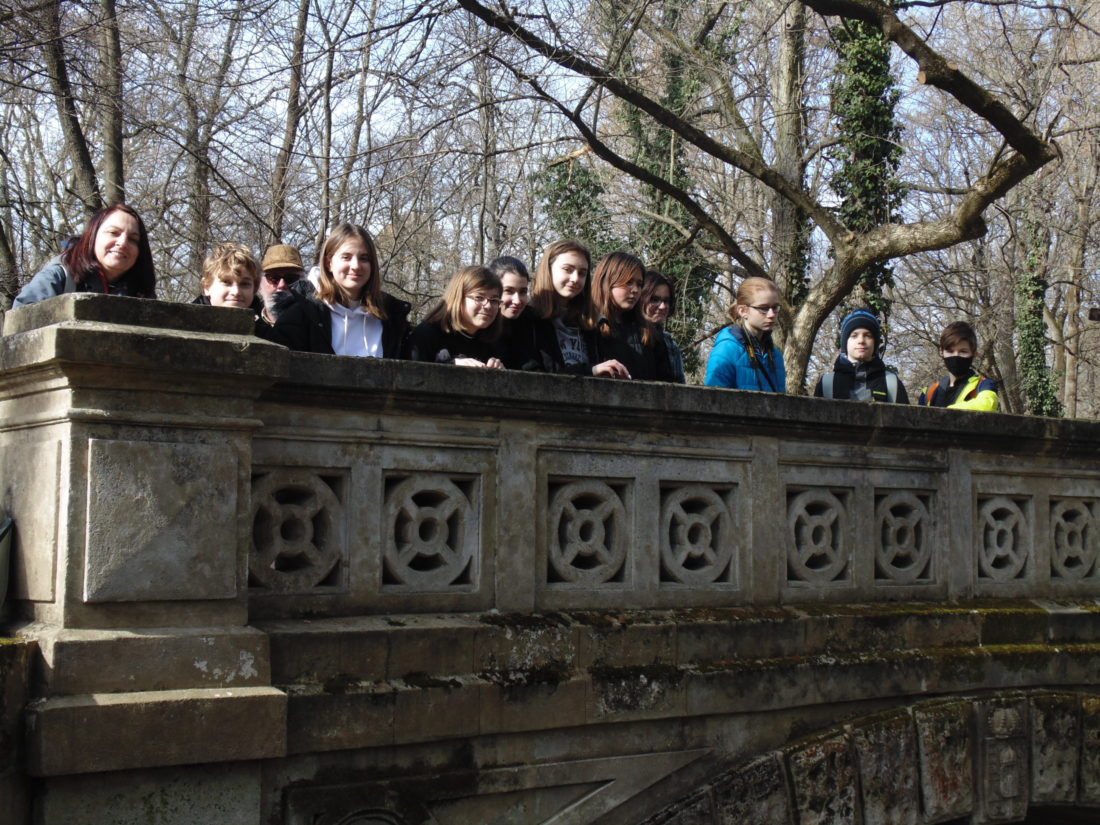
In the forest of snow drops
We left for Alcsút early today (February 26). Before the trip, we pulled a Dixit card in the doorway and uttered a word that came to mind about the picture. This helped our individual journey. The journey was long, but in the meantime we looked at beautiful landscapes. We arrived at the parking lot of the Alcsút Arboretum, where we saw a bunch of snowdrops a little further inside. We heard a great presentation from one of our groupmates, based on which we answered questions. We then stopped in front of a castle ruin to look around and relax. We continued on to Lovasberény, where we visited the Cziráky Castle and the exhibition organized there. Among the remaining trees of the English park next to the castle, we ran, played football, rocked on a swing attached to the largest tree in the park. At the end of the trip we visited a very nice Catholic church. ” – Hanna Faragó, Márk Török, Alex Pászti, Sz3 group, 7th grade students
We visited the Snowdrops Festival of the Alcsútdobozi Arboretum on Saturday (February 26). Alcsútdoboz is in Fejér county, so we left early. We walked along a wonderful path lined on both sides with a sea of snowdrops. Fanni Török made a description of the arboretum and also made a quiz about the places of interest and the snowdrops. We learned that the arboretum has a floor area of nearly 40 hectares, of which 2.5 hectares is associated with a snowdrop field. We took a look at the remains of a castle and the adjoining Romanesque church next to it. ” – Tünde Sztancsik, Sz3 group, 7th grade student
The Alcsút Arboretum welcomes visitors with a special attraction every spring. The entire area of the arboretum is the same as the English park of the classicist castle built by palatine Joseph. He was the palatine of the country, the first Habsburg to acquire property while settling in Hungary. The plants and trees found here date back to the 1820s. During the trip we had the opportunity to see the 2.5-hectare contiguous snowdrop of the 40-hectare arboretum and the surviving portico of the castle. The vegetation of the Alcsút Arboretum dates back to the 19th century. as a result of a plantation of the 19th century, a woody plant collection of 540 species. The English park was designed by Károly Tost, a master builder from Schönbrunn. Its most beautiful and oldest specimens include sycamores, Turkish hazelnuts, tulips, iron trees, beeches, swamp cypresses, fir trees, and Japanese acacia, but there is also a valuable collection of linden, maple, oak, and chestnut species. The giant stallion with 24 tribes, the water beech, the seven-stemmed Turkish hazelnut, the oldest 170-year-old Lebanese cedar in Hungary in the nearby Csaplári forest and the row of sycamore trees lining the Etyek road are of unique value.
After that we visited Cziráky Castle in Lovasberény. The earliest part of the complex was built in the late 15th century at the time of the Buzlay family. The Cziráky family acquired the castle and its estate in January 1730. A large “22-inch-wide and 36-inch-long” English landscape park was built around the classicist-style castle. In the park there is an artificial lake with a complicated floor plan with a small waterfall and an island. Unfortunately, we could only see traces of these. In the castle we visited an exhibition of nature photographers, as well as a serious collection of objects and photographers from the past of the castle. There was also an exhibition guide present, who also had a huge knowledge of the history of the settlement and the castle, and we joined an hour of his lecture. ” – Gyöngyi Novák, mentor of the Sz3 group
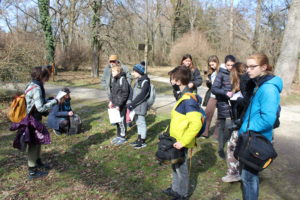
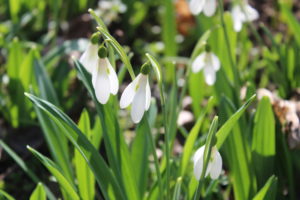
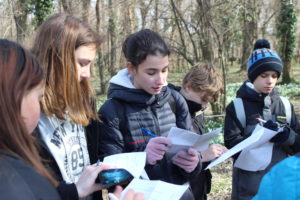
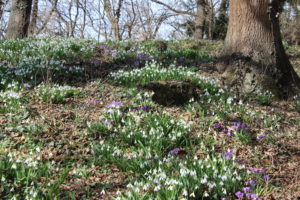
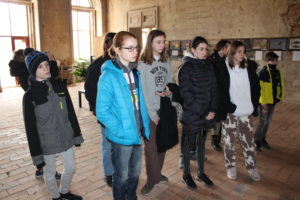
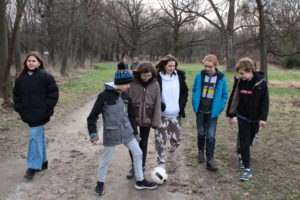
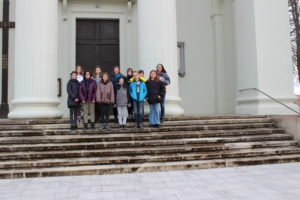
We left for Alcsút early today (February 26). Before the trip, we pulled a Dixit card in the doorway and uttered a word that came to mind about the picture. This helped our individual journey. The journey was long, but in the meantime we looked at beautiful landscapes. We arrived at the parking lot of the Alcsút Arboretum, where we saw a bunch of snowdrops a little further inside. We heard a great presentation from one of our groupmates, based on which we answered questions. We then stopped in front of a castle ruin to look around and relax. We continued on to Lovasberény, where we visited the Cziráky Castle and the exhibition organized there. Among the remaining trees of the English park next to the castle, we ran, played football, rocked on a swing attached to the largest tree in the park. At the end of the trip we visited a very nice Catholic church. ” – Hanna Faragó, Márk Török, Alex Pászti, Sz3 group, 7th grade students
We visited the Snowdrops Festival of the Alcsútdobozi Arboretum on Saturday (February 26). Alcsútdoboz is in Fejér county, so we left early. We walked along a wonderful path lined on both sides with a sea of snowdrops. Fanni Török made a description of the arboretum and also made a quiz about the places of interest and the snowdrops. We learned that the arboretum has a floor area of nearly 40 hectares, of which 2.5 hectares is associated with a snowdrop field. We took a look at the remains of a castle and the adjoining Romanesque church next to it. ” – Tünde Sztancsik, Sz3 group, 7th grade student
The Alcsút Arboretum welcomes visitors with a special attraction every spring. The entire area of the arboretum is the same as the English park of the classicist castle built by palatine Joseph. He was the palatine of the country, the first Habsburg to acquire property while settling in Hungary. The plants and trees found here date back to the 1820s. During the trip we had the opportunity to see the 2.5-hectare contiguous snowdrop of the 40-hectare arboretum and the surviving portico of the castle. The vegetation of the Alcsút Arboretum dates back to the 19th century. as a result of a plantation of the 19th century, a woody plant collection of 540 species. The English park was designed by Károly Tost, a master builder from Schönbrunn. Its most beautiful and oldest specimens include sycamores, Turkish hazelnuts, tulips, iron trees, beeches, swamp cypresses, fir trees, and Japanese acacia, but there is also a valuable collection of linden, maple, oak, and chestnut species. The giant stallion with 24 tribes, the water beech, the seven-stemmed Turkish hazelnut, the oldest 170-year-old Lebanese cedar in Hungary in the nearby Csaplári forest and the row of sycamore trees lining the Etyek road are of unique value.
After that we visited Cziráky Castle in Lovasberény. The earliest part of the complex was built in the late 15th century at the time of the Buzlay family. The Cziráky family acquired the castle and its estate in January 1730. A large “22-inch-wide and 36-inch-long” English landscape park was built around the classicist-style castle. In the park there is an artificial lake with a complicated floor plan with a small waterfall and an island. Unfortunately, we could only see traces of these. In the castle we visited an exhibition of nature photographers, as well as a serious collection of objects and photographers from the past of the castle. There was also an exhibition guide present, who also had a huge knowledge of the history of the settlement and the castle, and we joined an hour of his lecture. ” – Gyöngyi Novák, mentor of the Sz3 group









